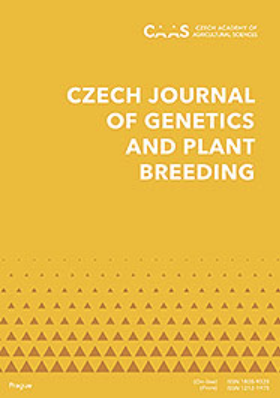水稻紫色柱头和紫色尖数量性状位点的珍山97B/明会63 RIL群体定位
IF 1.8
4区 农林科学
Q3 AGRONOMY
引用次数: 2
摘要
花青素色素沉着是水稻品种鉴定和连锁分析的重要形态标记。本文研究了紫柱头和紫尖的珍汕97与灰柱头和无色尖的明恢63杂交籼稻紫色柱头和紫尖性状的遗传因素。利用该杂交获得的重组自交系(RIL)群体对紫柱头和紫尖性状进行了数量性状位点(QTL)定位。将紫色柱头性状的一个主要QTL(暂称qPS-1-1)和紫色尖性状的一个主要QTL(暂称qPA-1-1)定位在6号染色体短臂Y4073L和*P两个标记之间。qPS-1-1和qPA-1-1的LOD峰值分别为44.0127和173.3585。qPS-1-1和qPA-1-1分别解释了总表型方差的66.7416%和98.6441%。珍山97等位基因使紫色柱头性状分别提高了8.0355% (qPS-1-1)和9.8863% (qPA-1-1)。此外,由于qPS-1-1和qPA-1-1具有强相关性,它们也位于6号染色体短臂上C基因的同一附近,这表明这两个QTL可能是相同的。通过与前人研究结果的比较,推测qPS-1-1或qPA-1-1为C基因,且对水稻尖部和柱头着色均具有多效性。本文章由计算机程序翻译,如有差异,请以英文原文为准。
Mapping of quantitative trait loci for purple stigma and purple apiculus in rice by using a Zhenshan 97B/Minghui 63 RIL population
Anthocyanin pigmentation is an important morphological marker that is commonly used to identify rice varieties and for linkage analysis. The following study investigates the genetic factors involved in the purple stigma (Ps) and purple apiculus (Pa) traits of an important indica rice cross between Zhenshan 97 (purple stigma and purple apiculus) and Minghui 63 (grey stigma and colourless apiculus). A recombinant inbred line (RIL) population derived from this cross was used for quantitative trait loci (QTL) mapping of the purple stigma and purple apiculus traits. As a result, one major QTL for the purple stigma trait, temporarily designated qPS-1-1, and one major QTL for the purple apiculus trait, temporarily designated qPA-1-1, were mapped to the short arm of chromosome 6 in the interval between the two markers Y4073L and *P. The LOD peaks of qPS-1-1 and qPA-1-1 were 44.0127 and 173.3585, respectively. In addition, qPS-1-1 and qPA-1-1 explained 66.7416% and 98.6441% of the total phenotypic variance, respectively. The Zhenshan 97 allele increased the purple stigma trait by approximately 8.0355% (for qPS-1-1) and 9.8863% (for qPA-1-1). Moreover, since qPS-1-1 and qPA-1-1 were strongly correlated, they were also located in the same vicinity of the C gene on the short arm of chromosome 6, which suggested that the two QTL might be the same. By comparing these and previous results, it was deduced that qPS-1-1 or qPA-1-1 was the C gene and was pleiotropic for both the colouration of the apiculus and the colouration of the stigma in rice.
求助全文
通过发布文献求助,成功后即可免费获取论文全文。
去求助
来源期刊

Czech Journal of Genetics and Plant Breeding
Agricultural and Biological Sciences-Plant Science
CiteScore
2.20
自引率
0.00%
发文量
25
审稿时长
>12 weeks
期刊介绍:
Original scientific papers, critical reviews articles and short communications from the field of theoretical and applied plant genetics, plant biotechnology and plant breeding. Papers are published in English.
 求助内容:
求助内容: 应助结果提醒方式:
应助结果提醒方式:


